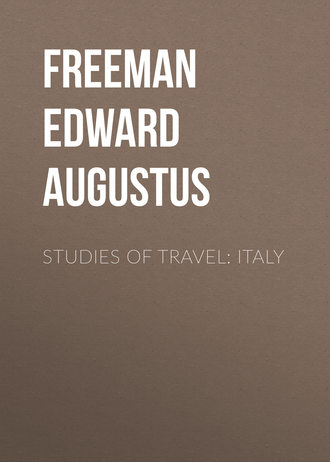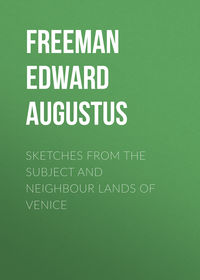 полная версия
полная версияStudies of Travel: Italy
We have been writing as we dreamed on the spot. As at Anagni, we wish – we must confess the weakness – to see independent Hernicans wherever we can. It gives us therefore a little shock when we come back and turn to our books, and find the walls of Hernican Ferentinum spoken of, without any special emotion, as "Roman." We look up again in a moment, and ask, What is Roman? At Ferentinum the word certainly means something quite different from what it commonly means in Britain and Northern Gaul. There we are happy if we light on anything earlier than the third century A.D. Here no one asks us to accept any date later than Sulla; some will allow us to go as far back as the middle of the second century B.C. We are allowed to think that the walls of Ferentinum were in being when old Carthage and old Corinth were still standing. But we have not yet got to our great piece of evidence. Ferentino contains inscriptions much older and more important – though about the comparative importance some might raise a doubt – than Aulus Quinctilius and his nuts. But we must get to them by the proper road; we must get into what once was the arx, what is now the ecclesiastical quarter. Now, at places like Ferentino, ecclesiastical and domestic buildings seem like something kindly thrown into the bargain. We go to look at walls, not at churches or houses; so we get something more than we asked for when we find that Ferentino contains many houses which are worth at least a glance, and several churches which are worth much more than a glance. Indeed at Ferentino the study of walls and that of churches cannot be kept asunder. That some of the great stones have been taken to build the small and now disused church of Saint Lawrence is a slight matter. The most striking feature of Ferentino in any distant view consists of the mass of buildings which is formed by piling the cathedral church, the bell-tower, and the Bishop's palace, on the walls of the arx, as a mighty sub-structure. The walls of the arx show the same two dates as the walls of the tower. In one part we have only the vast rude stones of the first period; at another part they support the upper range of the second. The first no one will refuse to our Hernicans, to Hernicans older than Spurius Cassius; but how about the second, the "Roman" date? This is claimed in several inscriptions as the work of the censors Aulus Hirtius and Marcus Lollius – censors, that is, not of Rome but of Ferentinum. The inscription may be seen in the first volume of the great Corpus Inscriptionum Latinarum, p. 238, and its closer likeness is given at fol. lxvii., lxviii. of the Priscae Latinitatis Monumenta Epigraphica. Now Aulus Hirtius and Marcus Lollius are names of a frightfully modern sound, suggesting well-known persons of the days of Divus Julius and Divus Augustus. But no one asks us to think of them here, though we may likely enough have got hold of the Hernican forefathers of those better-known Romans. They had no such need to change their names and the alphabet in which they are written, as when the son of the Etruscan Avle Felimne became the Roman Publius Volumnius. Now our Hirtius and Lollius claim to have built what they built from the foundation; but they must at the outside only mean that they built the later work on the top of the primæval wall. And to a zealous eye even the work of Hirtius and Lollius has an archaic look about it. There are no columns against the wall, as in the Tabularium of Catulus at Rome; the work is finished with a row of triglyphs, not unlike those on the tomb of "Cornelius Lucius Scipio Gnaivod patre prognatus." But we need not go back quite so far as his day. The further back we can go the better, but any time before Sulla will do. The history of Ferentinum allows us to carry our Hernicans of Ferentinum, like our Etruscans of Perusia, down to the Social War. Ferentinum, it must be remembered, was one of those Hernican towns which were true to Rome when Anagnia fought against her. What follows is most instructive. The men of Ferentinum, steady allies of Rome, refused the proffered reward of Roman citizenship, and chose rather to remain a distinct, even if a dependent, community. That is to say, the old Hernican city went on, as long doubtless as to the days of the Social War, a self-ordering commonwealth, with its own laws and magistrates – Aulus Hirtius and Marcus Lollius among them – subject only to the demands of military service which were needed in the wars of Rome, and sometimes perhaps to the unlawful excesses of powerful Romans.
This last fact comes out in a strange story told by Aulus Gellius (x. 3). It is an extract from a speech of Gaius Gracchus, setting forth the wrongs of the Italian allies. The wife of a Roman prætor suddenly wished the public baths of Ferentinum to be cleared and made ready for herself. The thing was not done so fast as the great lady wished; so her husband bade the two quæstors of the town to be seized; one was scourged, the other threw himself over the wall. This tale, told in the words of Gracchus, proves a good deal as to the arbitrary way in which Roman magistrates are not ashamed to deal with the dependent cities even of Italy, whatever might be their formal relation to Rome.
It is of less importance that Gellius casually speaks of the town as a municipium, while Livy also casually implies its possession of the Latin franchise. Such obiter dicta do not go for very much. Scholars sometimes get astray in these times from forgetting that, not only casual sayings, but even formal documents, may sometimes err. Thus not long ago we saw a solemn paper in which a public officer, bound to accuracy, a clerk of the peace, had to describe several towns in the West of England. We here read of "the county of the city of Bristol," the "borough of Gloucester," the "borough of Bath," and the "borough of Taunton." An inquirer some ages hence might be misled into forgetting that Bath is a "city" and Gloucester even a "county of a city." May we not sometimes get wrong about municipia and Latin colonies from the same kind of cause? Ferentinum was not, in the strict sense, a municipium, but an allied Hernican commonwealth. In the like sort, we once saw an official document from a high sheriff calling on the electors of a county to elect, not a "knight of the shire," as they had done for six hundred years, but a hitherto unheard-of being called a "member of Parliament." Is it not possible then that Livy, and even Cicero, may sometimes use a wrong phrase in talking of tribes, curiae, and centuries, in ages long before their own day?
The walls then, though called "Roman" in a vague sense – that is, it would seem, simply not primæval, like those of Cori and Segni – are doubtless Hernican in the sense of being built while Ferentinum was still a separate Hernican community. The walls that we see are most likely the walls over which the unlucky quæstor threw himself. The walls of the arx, where we read the legend of Hirtius and Lollius, connect the Hernican town with later times. Just at the point where the inscription is they are carried up to form the Bishop's palace, and from the middle of one side rises the bell-tower of the cathedral – a very good example of the usual Romanesque type of such buildings. The church of Ferentino is small and unpretending, and a good deal damaged within, but it still keeps its main features, not only its bell-tower, but its west front, its apses, its ranges of windows. A little restoration, in the true sense of the word, would soon make it into as good a specimen of its own class as could be needed. But, unless we altogether misunderstood the words of one of its own clergy, antiquity and simplicity are not esteemed at Ferentino. The little minster is convicted of the crime of being old, a charge which, except by comparison with the walls beneath it, cannot be denied. Only, if the church be an offender on this score, how fearful must be the crime of the walls? Unless we misunderstood in the most amazing way what we heard with our own ears, the church of Ferentino, convicted of the crime of old age, is sentenced to destruction. A new church is actually begun; when it is finished the old one is to go. Happily the new one as yet stands still for want of funds; let us hope that funds may refuse to drop in till a wiser Bishop and Chapter shall rule at Ferentino.
The church at Ferentino is dedicated to Saint Ambrose, who may be seen there in the worldly garb of the unbaptized prefect, before the infant voice greeted him as Bishop of Milan. And in the inner buildings of the arx– buildings most worthy of a visit on their own account – strange tales lurk of the sufferings of the saint, which seem to find no place either in history or in received legend. Among other things he was thrown into a boiling caldron. Down below is another church Santa Maria Maggiore, some centuries younger than the cathedral, and a very pretty example of its style; which, as far as we know, no one designs to destroy. Singularly graceful, but singularly un-Italian, it strikes by the power of contrast, as it rises above the walls, or as we go up to it from the gate which shares its surname. A few other ecclesiastical and domestic scraps may also be picked up in the city of the rock. The primitive remains are the great object in all these places; but it is always a gain when the walls shelter something which has an interest of another kind. The walls of the stout-hearted people who chose rather to be citizens of Ferentinum than citizens of Rome lose nothing by having been turned to an unlooked-for use as the holy places of their successors, perhaps descendants, of another age and another creed.
III. Alatri
The tale of those Hernican cities, fenced in with primæval walls, among which we have been lately sojourning, is worthily brought to an end at Alatri. Among its immediate Hernican fellows that town must certainly claim the highest place; it might on some grounds claim the highest place, even if we throw in Old-Latin and Volscian rivals. Yet it is the one which has the least history. There is very little to say about it, except that Alatrium, like Ferentinum, was faithful to Rome, but preferred to keep its separate Hernican being rather than accept the proffered reward of Roman citizenship. It therefore doubtless remained a distinct commonwealth down to the Social War. And here at least there can be no question about dates. Alatri is not especially rich in mediæval antiquities; it has still less claim to be called rich in Roman antiquities. Nor does it supply us with the work of more or less Romanized Hernicans, like the censors of Ferentinum. At Alatri nearly everything that we care about is strictly primæval. We cannot reasonably doubt that both the circuits of wall at which we now look were there in the days of Spurius Cassius, and were by no means new then.
Alatri seems to have been somewhat of an out-of-the-way place in all ages. Not lying on any of the great roads of Italy, it has no place in the Itineraries, and now it lies much further than Anagni or Ferentino – nay, even than Cori and Norba, from common tracks of going and from the common haunts of men. Yet it cannot be looked on as seriously inaccessible; it may at least be reached without calling in the help of asses and mules. The party whose track we are now following – a party, be it noticed, numbering two ladies among them – reached Alatri in a carriage from Frosinone, having slept there after seeing Ferentino. The old Hernican town of Frusino had scant justice done to it by our wayfarers; as no man or book had pointed it out as a seat of primitive walls, it was treated merely as a resting-place between the wonders of Ferentino and the wonders of Alatri. Frosinone was slept in, but was not examined; yet a glance from its railway station, the point which connects Alatri with the modern world, shows that it at least possesses a by no means contemptible bell-tower. From Frosinone then our travellers made their way to Alatri, and, as Alatri gradually rose before them, they were for a while puzzled, perhaps for a while even disappointed, with what they saw. But it was not for lack of a striking object to crown the Alatrian hill-top. Of all the walls of our series, the inner range of the walls of Alatri, the walls which fence in the arx, are the most prominent in a distant view. Even the circuit of empty Norba, beyond our immediate range, hardly outdoes these defences of a still inhabited town. At Alatri indeed the primæval walls are so prominent that in the distant view no one would suspect them of being primæval walls at all. They are still so nearly perfect that they can and do discharge what may be looked on as a survival of their original function. They still fence in the innermost and loftiest quarter of the town, where, as in so many other cases, the ancient citadel has become the episcopal precinct. But at Alatri the episcopal precinct puts on a distinct and central character which is rarely found in Italian cities. The arx is not in a corner, but in the middle; the lower town, fenced in by the wall of its own outer circuit, lies around it on every side. The arx forms an open, lofty, and airy platform, looking forth from every point of the compass on the mountains which keep watch around – on the little towns, Veroli among them, perched here and there on their heights – on the houses and churches of Alatri, covering the slope of the hill which the arx crowns. It is seldom that we find in an Italian town a church or any other building standing in this way free on a commanding site, not hemmed in on any side by parasitical buildings. These hill-towns are perhaps better off in this respect than most others; at Anagni, at Ferentino, the cathedral churches stand grandly on their heights, comparatively free from all buildings except their own proper companions. But there is not the wide, open space around them which surrounds the church of Alatri. One cannot help wishing that some more worthy building, either the primæval temple itself or some more fitting successor, occupied so noble a site, a site in truth which needs – let us say either the Parthenôn of Athens or the Parthenôn of Lincoln to do it justice. But the only thing that can be said for the cathedral church of Alatri is that the lower part of its wall is part of the cella of the primæval temple. Here we have something even more than can be seen at Segni. We know not what may have been added in the way of a pillared front; but it is plain that, as far as the main walls are concerned, the building which was transformed into a Christian church was actually the house of pagan worship itself. And it was a house going back, not to dated Emperors or consuls, but to the unrecorded age which reared these cities great and fenced up to heaven. There is the terrace, there is the wall of the cella, wrought of the same wonderful masonry as the walls of the surrounding arx, as the walls of the yet again surrounding city. It is strange indeed to see the ordinary rites of Christian worship, the ordinary accompaniments of a Christian church, dwelling, as at Rome and Syracuse, within the temples of a creed, fallen indeed but perfectly familiar. But here we see them within walls reared in honour of we know not what – gods of unchronicled days, gods alongside of whom Jupiter of the Capitol may have seemed as strange and foreign as Mithras and Serapis now seem alongside of Jupiter of the Capitol.
Where the præhistoric temple has thus become the cathedral church, it is not out of keeping that the wall of the præhistoric arx should become the wall of the cathedral close. This is the wall which we see from afar, a wall which seems so straight and regular, so clearly furnished with a modern finish at top, that it is not till we can distinguish the mighty blocks of which it is formed that it has the air of a wall even of Roman, even of mediæval, antiquity. Shall we say it? As we looked up at no very amazing distance, the wall of the arx of Alatri had a good deal of the air of the wall of a modern prison. We could not yet see the construction, and the outline seemed more regular and rectangular than it proves to be. Nowhere do we better see than at Alatri the nature of these primitive walls. They are seldom walls in the same sense as the later walls of Rome or of other places, walls built on the ground and standing up clear on both sides. Their business commonly is, as is perhaps more clear at Alatri than anywhere else, to strengthen by masonry the scarped side of a hill. Hence they have little or no height within, and the gateways are necessarily reached from within by a steep descent. The open space at Alatri allows this arrangement to be studied with unusual ease. The wall is eminently a wall against a hill, and its arrangements are made with no small art. The weak corner has its double defence; the way up from the town at this point is carefully sheltered. And what stones they are with which the hill of Alatri is strengthened; above all, what stones they are which are piled together to form its main gateway. Nowhere indeed in the walls of Alatri, whether of temple, arx, or city, do we find anything quite so rude as the rudest part of the wall of Cori. All the stones, of whatever shape – and they are of many shapes – have clearly been cut; they are all laid according to some kind of system, though the system according to which they are laid is not the same in every part of the wall. In some parts they seem almost to take the shape of constructive arches, at least of attempts at arches, such as may be seen in gateways and roofs at Segni and elsewhere. The true arch, it is hardly needful to say, is nowhere found in the original work; nor do we find even any of the attempts at the arch in that position where we should have most naturally looked for them, in the gateways. The great gateway of the arx at Alatri is indeed a wonderful work. Its builders either knew the arch and despised it, or else the thought of the arch had not come into their heads. It is as pure an example of the lintel-construction as any gateway at Athens or Mykênê. We suppose that the lintel-stone of the great treasury is yet vaster than the huge lintel-stone at Alatri; but the Anakim of Alatri were at least rivals whom those of Mykênê could not have despised. But, except in vastness of construction, we must not compare the gateway at Alatri, perfectly plain, a mere piling, though a very skilful piling, of huge blocks with the really artistic work of the Mykênaian treasuries. It goes rather with the lion-gate; only there are no lions. The builders of Alatri could carve, as is shown over one of the smaller gateways of the arx. But they chose to carve quite other subjects than lions. On the great gate however they carved nothing; that is left in the stern majesty of the vast blocks which form it. And here we may distinguish between the cut blocks of the gateway itself and the far ruder blocks just within it, which merely formed part of the foundation, and which, when the steep path went down to the gate, would not have stood above ground. Even the builders of primæval walls clearly drew a line between what was meant to meet the public eye and what was not.
But we must remember that the walls of which we have been speaking, the walls which first catch the eye, are not the whole of the walls of Alatri. They fence in only its inner and higher circuit. Their effect in the distant view is so imposing that the visitor will most likely be tempted to go to them first, instead of doing things in a more regular order by first tracking out the walls of the town itself. But these last, except that they do not supply anything like the primæval gate, are just as well worthy of study as the walls of the arx itself. They remain perfectly round the greater part of the circuit of the city, and they are of the same general construction as the walls of the arx. At some points a singular contrast is made by mediæval additions to the defences; good thirteenth century work, with the characteristic windows of the time, stands out as projections from the primæval wall. And, as in some of the other places, we have something thrown in in the way of what the walls contain, besides the attractions of the walls themselves. From the arx of Alatri we look down on several bell-towers and rose-windows, and one church at least, that of Santa Maria Maggiore, though hardly equal to its namesake at Ferentino, is quite worthy of examination. But, next to its walls, the strong point of Alatri lies in its domestic buildings. Very seldom, in Italy or out of it, do we see graceful windows, chiefly couplets with a divided shaft, more thickly gathered together, than in its crooked and narrow streets. Alatri, in short, is, to the antiquarian eye, satisfactory in every point save one. There should have been some decent building, pagan or Christian, crowning the noble site of its arx, the noblest in our whole range.
With Alatri we end one main stage of our iter, that of the hill-cities. We shall henceforth pass by places which lie more in the world, some of them in the thick of modern communication. But if we had turned back at Alatri, we should have done a good stroke of work. A journey to the walls of the Hernicans is in every way pleasant and profitable. And in truth, even if we throw in the Old-Latins and the Volscians, it is not a journey of hardships. The little inns are very humble, very simple, but they may be fed in and slept in without anything very frightful to endure. It may perhaps be well to mention that the Locanda d'Italia, at Anagni, recommended in various guide-books, has ceased to exist for some years. Still a day and a night at Anagni are no hardship, and a guide may be found, shirtless and letterless, who knows what is really worth going to much better than many in England who boast at once more clothes and more learning. Indeed, the men of the walls seem altogether a kindly and well-disposed race. Some say that is because they are said to be reclaimed brigands, perhaps on the principle that a reformed rake used to be said to make the best husband. There are indeed more beggars among them than need be; but on this head a wise rule was laid down by a young Volscian, or he might be a Hernican – we cannot always be exact among these obsolete nationalities – "Give to the halt and the blind; but not to anybody else."
IV. From Alatri to Capua
We have done for a while with the hill-cities, though it would not be hard to find several other spots of the same kind, rivalling in historical interest, and, by all accounts, rivalling also as to existing remains, any of those which we have gone through. But the special necessities of an iter ad Brundisium carry us to quite other parts of the Italian peninsula, to parts where the sources of interest are fully equal to those of Etruscan or Latin cities, but where they are wholly different in kind. We leave the hills, or touch only their lowest slopes. For a while the mountains still soar above us, while our work is in the plains. Presently we lose the mountains even as distant companions; but before long we have the blue waves of Hadria as their substitute. At last we reach our goal; we go for a season even beyond it. And when we have gone as far as the devices of modern science can carry us, when we have reached the very end of the general railway system of Central Europe, our landscape again takes in both the sea and the mountains. But the eye now ranges beyond the bounds of Italy, beyond the bounds of Western Europe. We see across the narrowed waters to the heights of another peninsula. Without seeking for more than a chance likeness between the names – a name that ranges from the Euxine to the Hudson – without seeking in any sort to identify the Ἀλβανοί of Dionysios and the Ἀλβανοί of imperial Anna, it is still with a curious feeling of coincidence that the eyes which not many days before were looking up to the mount of Alba, now look across the sea to the wilder mountains of Albania.
Some of those who now looked across had already learned something of those heights from earlier and nearer experiences. Still it is a new feeling to look out on them from Italian ground, above all to look out on them from the spot where the Turk made his entrance into the western world, and where the signs of his short presence have stamped themselves deep on local memory. Standing at Otranto, looking on the Albanian heights, the foremost thought is how near Otranto came to being to the West of Europe all that the Thracian Kallipolis was to the East. But we are as yet far from Otranto, far from the heel of the boot, far even from any point of the Hadriatic coast. We are still on the western side of the great backbone of Italy; we have still to catch glimpses of the Tyrrhenian waters, to look, as at distant objects, on the bold outline of Ischia and on Vesuvius crowned with his pillar of cloud. But this time we do not obey the seemingly inflexible law which decrees that he who goes to Rome and does not turn back from Rome must go and see Naples, whether he dies after the sight or not. This time we have no call either to Naples itself or to the far more attractive range of objects of which Naples is the centre. Our errand is to pass from the primæval cities of the Latin and the Volscian to the cities of south-eastern Italy. Their chief present attraction lies in the series of churches raised in the days of the Norman and Angevin kings; but their memories carry us back through a long series of stirring ages, not indeed to the hoary antiquity of Cori and Alatri, but to the days when Southern Italy, the earliest Italy, was counted for a part of Hellas. It is not for nothing that we look out from thence on those eastern lands which then perhaps were the less Hellenic of the two.







